
Concept explainers
21ST CENTURY EDUCATION PRODUCTS
OTHER TOPICS IN CAPITAL BUDGETING 21st Century Educational Products (21st Century) is a rap idly growing software company, and consistent with its growth, it has a relatively large capital budget Although most of the company’s projects are fairly easy to evaluate, a handful of projects involve more complex evaluations.
John Keller, a senior member of the company’s finance staff, coordinates the evaluation of these more complex projects. His group brings their recommendations directly to the company’s CFO and CEO, Kristin Riley and Bob Stevens, respectively.
- a. In recent months, Keller’s group has focused on real option analysis.
- 1. What is real option analysis?
- 2. What are some examples of projects with real options?
- b. Considering real options, one of Keller’s colleagues, Barbara Hudson, has suggested that instead of investing in Project X today, it might make sense to wait 1 year because 21st Century would learn more about market conditions and would improve its
forecast of the project's cash flows. Right now 21st Century forecasts that Project X will generate expected cash flows of $33,500 for 4 years. However, if the company waits 1 year, it will learn more about market conditions. There is a 50% chance that the market will be strong and a 50% chance that it will be weak. If the market is strong, the annual cash flows will be $43,500. If tire market is weak, the annual cash flows will be only $23,500. If 21st Century chooses to wait 1 year, the initial investment will remain $100,000, and cash flows will continue for 4 years after the initial investment is made. Assume that all cash flows are discounted at 10%. Should 21st Century invest in Project X today, or should it wait a year before deciding whether to invest in the project? - c. Now assume that there is more uncertainty about the future cash flows. More specifically, assume that the annual cash flows are $53,500 if the market is strong and $13,500 if the market is weak. Assume that the upfront cost is still $100,000 and that the WACC is still 10%. Will this increased uncertainty' make the firm more or less willing to invest in the project today? Explain.
- d. 21st Century is considering another project, Project Y. Project Y has an up-front cost of $200,000 and an economic life of 3 years. If the company develops the project, its after-tax operating costs will be $100,000 a year, however, the project is expected to produce after-tax
cash inflows of $180,000 a year. Thus, the project’s estimated cash flows are as follows:
|
|
|
|
| 0 | ($200,000) | $0 | ($200,000) |
| 1 | (100,000) | 180,000 | 80,000 |
| 2 | (100,000) | 180,000 | 80,000 |
| 3 | (100,000) | 180,000 | 80,000 |
- 1. The project has an estimated WACC of 10%. What is the project's expected NPV?
- 2. Although the project’s operating costs are fairly certain at 5100,000 per year, the estimated cash inflows depend critically on whether 21st Century’s largest customer uses the product. Keller estimates that there is a 60% chance that the customer will use the product, in which case the project will produce after-tax cash inflows of $250,000. Thus, its estimated project cash flows will be $150,000 per year However, there is a 40% chance that the customer will not use the product, in which case the project will produce after-tax cash inflows of only $75,000. Thus, its estimated project cash flows will be -$25,000. Write out the estimated cash flows, and calculate the project’s expected NPV under each of the two scenarios.
- 3. Although 21** Century does not have the option to delay the project, it will know 1 year from now whether the key customer has selected the product. If the customer chooses not to adopt the product, 21** Century has the option to abandon the project. If 21- Century abandons the project, it will not receive any cash flows after Year 1, and it will not incur any' operating costs after Year 1. Thus, if the company chooses to abandon the project, its estimated cash flow's will be as follows:

Again, assuming a WACC of 10%, what is the project’s expected NPV if it abandons the project? Should 21st Century invest in Project Y today, realizing it has the option to abandon the project at t = 1?
- 4. Up until now, we have assumed that the abandonment option has not affected tile project’s WACC. Is this assumption reasonable? How might the abandonment option affect the WACC?
- e. Finally, 21st Century is also considering Project Z. Project Z has an up-front cost of $500,000, and it is expected to produce cash flows of $100,000 at the end of each of the next 5 years (t = 1, 2, 3, 4, and 5). Because Project Z has a WACC of 12%, it clearly has a negative NPV. However, Keller and his group recognize that if 21st Century goes ahead with Project Z today, there is a 10% chance that this will lead to subsequent opportunities that have an expected
net present value at t = 5 equal to $3,000,000. At the same time, there is a 90% chance that the subsequent opportunities will have an expected negative net present value (-$1,000,000) at t = 5. On the basis of their knowledge of real options, Keller and his group understand that the company will choose to develop these subsequent opportunities only if they appear to be profitable at t = 5. Given this information, should 21st Century invest in Project Z today? Explain your answer.
a)
To discuss: The meaning of real option analysis.
1.
A contract to purchase a financial asset from one party and sell it to another party on an agreed price for a future date is termed as Option.
Explanation of Solution
The meaning of real option analysis is as follows:
A real option takes place when the company’s mangers can influence on the riskiness and size of the cash flows of the project by way of undertaking various actions at the end of the project’s life. This real option analysis include a benefit analysis on the Net present value (NPV) capital budgeting. It is done with a study of opportunities resulting from the manager’s responses to change outcomes of the project.
2.
To discuss: The example of projects with real options.
Explanation of Solution
The examples of projects with real options are as follows:
- Abandonment option is a type of real options. It is an option to end a particular project when the project’s operating cash flows are lower as compared to the expected cash flows.
- Growth option is also a type of real options. It exists when the investment creates an opportunity to make profitable investments.
- Flexibility options are also a type of real options. This option allows a company to change its operations based on the changes of current conditions during the life of the project. As a result, inputs, outputs, or both can be altered easily according to the present market demands.
b.
To discuss: Whether the C Company has to invest in Project X at present or wait for one-year before deciding to invest in the project.
Explanation of Solution
Given information:
C Company has decided to invest in Project X. The expected cash flows from the project at present are $33,500 for 4-years period. This project indicates that there is a 50% chance that the market will be strong and there is even 50% chance that the market condition will be weaker. The annual cash flows are $43,500 when the market condition is strong and $23,500 when the market is weak. The initial investment is $100,000 and discounted rate is 10 percent.
Compute the NPV for doing the project at present:
The table below shows the Excel formula to calculate the NPV for doing the project at present:

The table below shows the calculated values of NPV for doing the project at present:
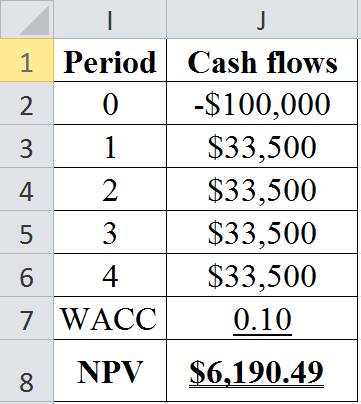
Hence, the NPV for doing the project at present is $6,190.49.
Compute the NPV of waiting to do project:
Note: At the time when the project has 50 percent chance of good conditions.
The table below shows the Excel formula to calculate the NPV of waiting to do project:
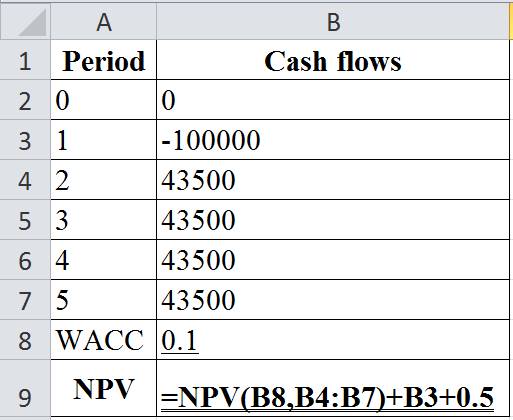
The table below shows the calculated values of NPV of waiting to do project:

Hence, the NPV when the project is in good condition is $37,889.65.
Compute the NPV:
Note: At the time when the project has 50 percent chance of weaker market.
The table below shows the Excel formula to calculate the NPV of waiting to do project:
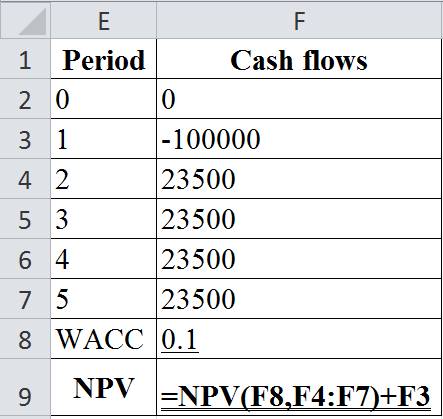
The table below shows the calculated values of NPV of waiting to do project:

Hence, the NPV when the project is in bad condition is −$25,508.16. Therefore, the company cannot undertake the project in the weaker market because its NPV is less than zero.
Compute the expected NPV of waiting one-year:
Hence, the expected NPV of waiting one-year is $18,944.825. This is the present value for one-year, so it has to be discounted back to determine the current value for waiting to undertake the Project X. As a result, the present value of waiting is $17,222.57
c.
To discuss: Whether the increased uncertainty makes the company more or less willing to invest in the project at present.
Explanation of Solution
Given information:
The C Company’s project has more uncertainty regarding the future cash flows. The annual cash flows are $53,500 when the market is strong and $13,500 when the market is weak. The initial cost is $100,000 and the WACC is 10 percent.
Compute the NPV for strong market condition case:
The table below shows the Excel formula to calculate the NPV:
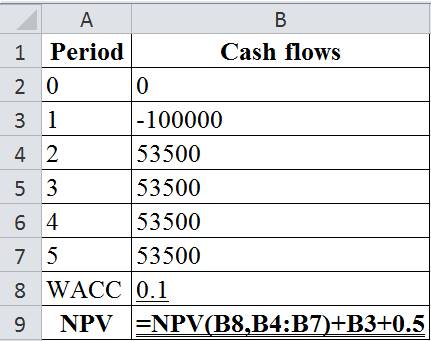
The table below shows the calculated values of NPV:

Hence, the NPV when the project is in strong market condition is $69,588.30.
Compute the NPV for weaker market condition case:
The table below shows the Excel formula to calculate the NPV:
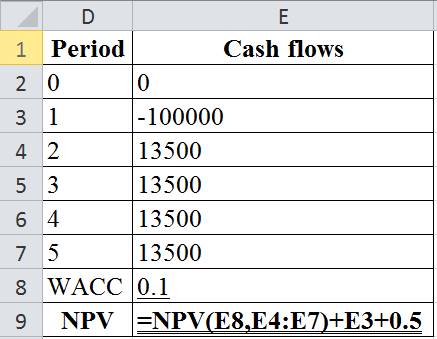
The table below shows the calculated values of NPV:
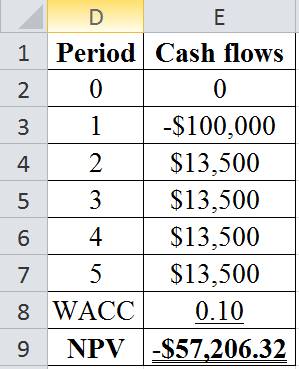
Hence, the NPV when the project is in bad condition is −$57,206.32. Therefore, the company cannot undertake the project in the weaker market because its NPV is less than zero.
Compute the expected NPV of waiting one-year:
Hence, the expected NPV of waiting one-year is $34,794.15. This is the present value for one-year, so it has to be discounted back to determine the current value for waiting to undertake the Project X. As a result, the present value of waiting is $31,631.05
d.
To discuss: The expected NPV of the project.
1.
NPV is the variation between the present value of the cash outflows and the present value of the cash inflows. In capital budgeting, the NPV is utilized to analyze the profitability of a project or investment.
Explanation of Solution
Given information:
C Company is considering another project that is Project Y. The initial cost of this project is $200,000 and the economic life of the project is 3-years. The after-tax operating cost is $100,000 per year, WACC is 10 percent, and expected after-tax cash inflows are $180,000 a year. The project’s estimated cash flows are as follows:
| Year |
Cash outflows |
Cash inflows |
Estimated project cash flows |
| 0 | -$200,000 | $0 | -$200,000 |
| 1 | -$100,000 | $180,000 | $80,000 |
| 2 | -$100,000 | $180,000 | $80,000 |
| 3 | -$100,000 | $180,000 | $80,000 |
Compute the NPV:
The table below shows the Excel formula to calculate the NPV:
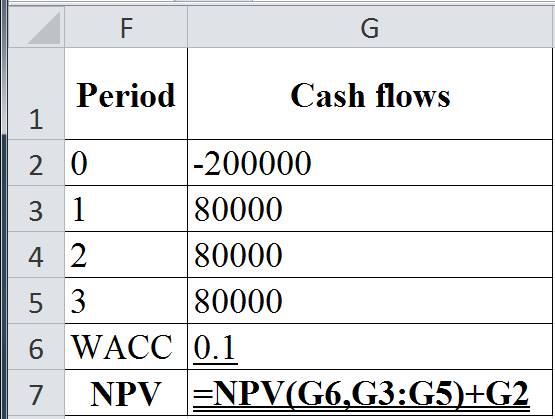
The table below shows the calculated values of NPV:

Hence, the expected NPV is −$1,051.84.
2.
To find: The expected NPV of the project in each scenario.
Explanation of Solution
Given information:
The operating cost of the project is $100,000 per year. This project indicates that there is a 60% probability that the customers will use the product and produce after-tax cash inflows of $250,000. The estimated cash flows of the project will be $150,000 per year. Even there is 40% chance that the customer will not use the product and produce after-tax cash inflows of $75,000. In this case, the estimated project’s cash flows is −$25,000.
Compute the NPV when customer uses the product:
The table below shows the Excel formula to calculate the NPV:
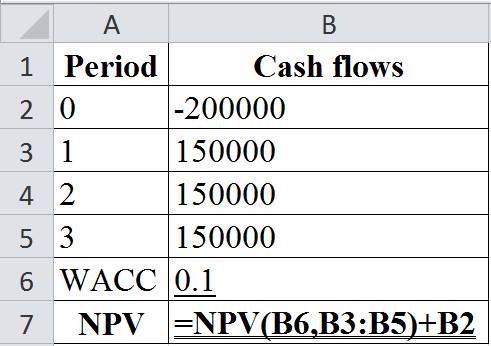
The table below shows the calculated values of NPV when customer uses the product:
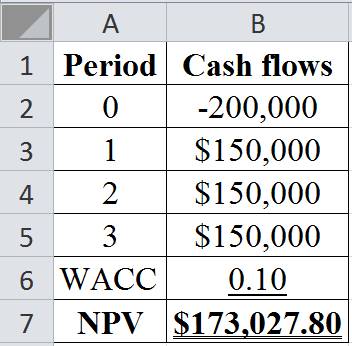
Hence, the NPV when customer uses the product is $173,027.80.
Compute the NPV when customer does not use the product:
The table below shows the Excel formula to calculate the NPV:
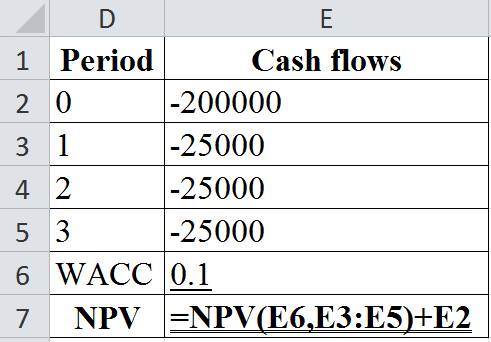
The table below shows the calculated values of NPV when customer does not use the product:
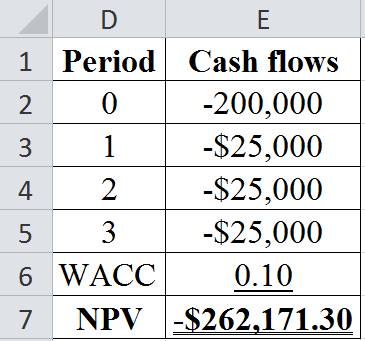
Hence, the NPV when customer does not use the product is −$262,171.30.
Compute the expected NPV:
Hence, the expected NPV is −$1,051.84.
3.
To find: The expected NPV of the project.
Explanation of Solution
Given information:
The operating cost of the project is $100,000 per year. This project indicates that there is a 60% probability that the customers will use the product and produce after-tax cash inflows of $250,000. The estimated cash flows of the project will be $150,000 per year. Even there is 40% chance that the customer will not use the product and produce after-tax cash inflows of $75,000. In this case, the estimated project’s cash flows is −$25,000.
Compute the NPV when there is 60% chance:
The table below shows the Excel formula to calculate the NPV:
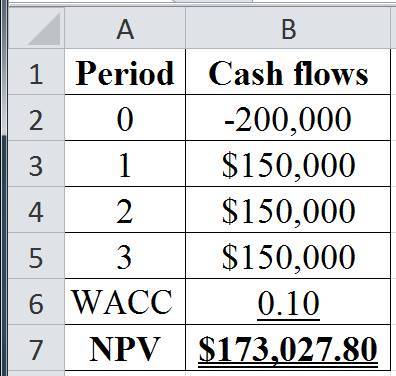
The table below shows the calculated values of NPV when there is 60% chance:
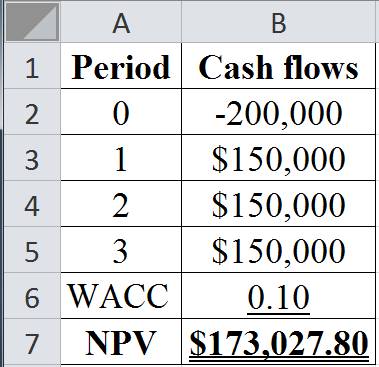
Hence, the NPV when there is 60% chance is $173,027.80.
Compute the NPV when there is 40% chance:
The table below shows the Excel formula to calculate the NPV:
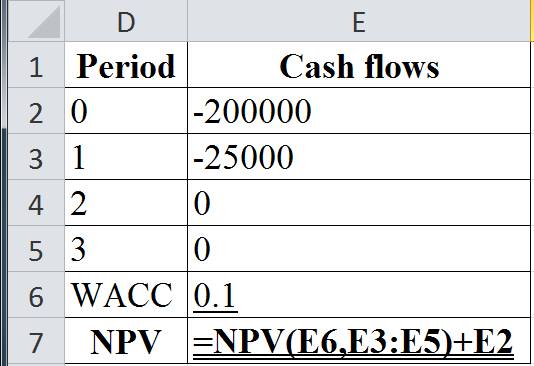
The table below shows the calculated values of NPV when there is 40% chance:
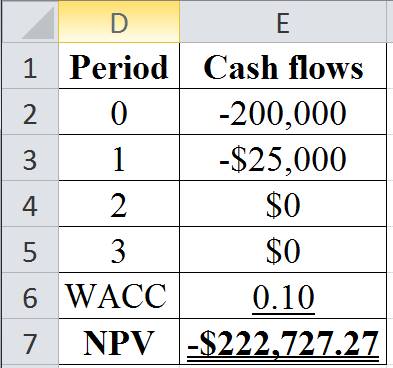
Hence, the NPV when there is 40% chance is −$222,727.27.
Compute the expected NPV:
Hence, the expected NPV is $14,725.772. Therefore, the C Company can execute the project currently.
4.
To discuss: Whether the assumption is reasonable and ways in which the abandonment option affect the WACC.
Explanation of Solution
Determine whether the assumption is reasonable and ways in which the abandonment option affect the WACC:
The assumption is not reasonable to assume that the abandonment option has not effected on the WACC of the project. The abandonment option has the ability to reduce risk and it even reduces the WACC of the project.
e.
To find: Whether the C Company has to invest in Project Z at present.
Explanation of Solution
C Company has decided to invest in Project Z. The initial cost of this project is $500,000 and the expected cash flows produced is $100,000 at the end of next 5-years. The WACC is 12 percent and there is 10 percent chance that the expected NPV of the project will be $3,000,000. Even there is 90 percent chance that the expected NPV will be −$1,000,000.
Compute the NPV when there is 10% chance:
The table below shows the Excel formula to calculate the NPV:
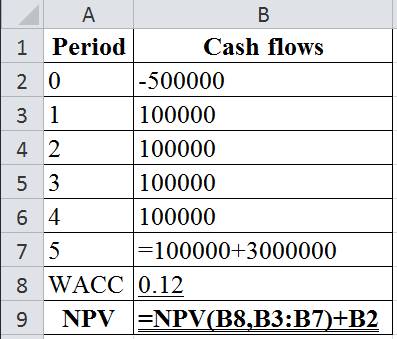
The table below shows the calculated values of NPV when there is 10% chance:
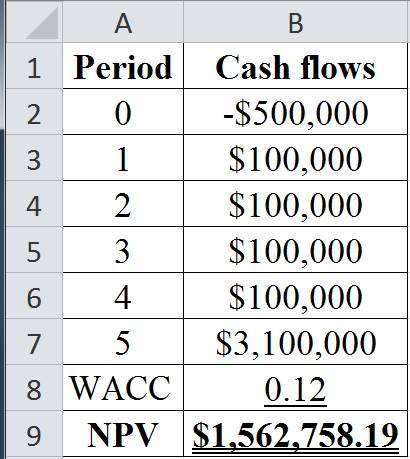
Hence, the NPV when there is 10% chance is $1,562,758.19.
Compute the NPV when there is 90% chance:
The table below shows the Excel formula to calculate the NPV:
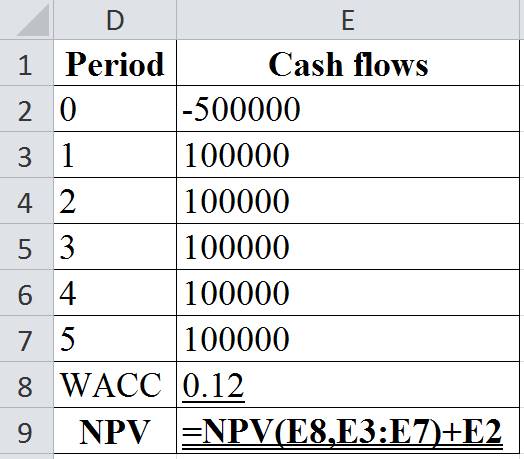
The table below shows the calculated values of NPV when there is 90% chance:
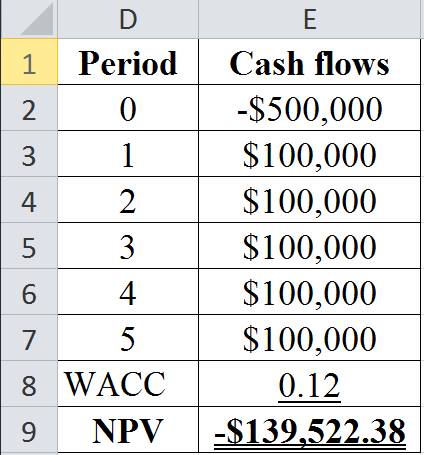
Hence, the NPV when there is 90% chance is −$139,522.38. The C Company will not undertake the project that has a negative NPV of future opportunities. Therefore, the cash flows include only $500,000 and $100,000 inflows.
Compute the expected NPV:
Hence, the expected NPV is $30,705.68. Therefore, the Project Z has a positive NPV so the C Company can invest in the project at present.
Want to see more full solutions like this?
Chapter 13 Solutions
Bundle: Fundamentals Of Financial Management, Loose-leaf Version, 15th + Mindtapv2.0 Finance, 1 Term (6 Months) Printed Access Card
- A sporting goods manufacturer has decided to expand into a related business. Management estimates that to build and staff a facility of the desired size and to attain capacity operations would cost $450 million in present value terms. Alternatively, the company could acquire an existing firm or division with the desired capacity. One such opportunity is a division of another company. The book value of the division’s assets is $250 million and its earnings before interest and tax are presently $50 million. Publicly traded comparable companies are selling in a narrow range around 12 times current earnings. These companies have book value debt-to-asset ratios averaging 40 percent with an average interest rate of 10 percent. a. Using a tax rate of 34 percent, estimate the minimum price the owner of the division should consider for its sale. b. What is the maximum price the acquirer should be willing to pay? c. Does it appear that an acquisition is feasible? Why or why not? d. Would a 25…arrow_forwardLarry Davis borrows $80,000 at 14 percent interest toward the purchase of a home. His mortgage is for 25 years. a. How much will his annual payments be? (Although home payments are usually on a monthly basis, we shall do our analysis on an annual basis for ease of computation. We will get a reasonably accurate answer.) b. How much interest will he pay over the life of the loan? c. How much should be willing to pay to get out of a 14 percent mortgage and into a 10 percent mortgage with 25 years remaining on the mortgage? Assume current interest rates are 10 percent. Carefully consider the time value of money. Disregard taxes.arrow_forwardYou are chairperson of the investment fund for the local closet. You are asked to set up a fund of semiannual payments to be compounded semiannually to accumulate a sum of $250,000 after nine years at a 10 percent annual rate (18 payments). The first payment into the fund is to take place six months from today, and the last payment is to take place at the end of the ninth year. Determine how much the semiannual payment should be. (a) On the day, after the sixth payment is made (the beginning of the fourth year), the interest rate goes up to a 12 percent annual rate, and you can earn a 12 percent annual rate on funds that have been accumulated as well as all future payments into the funds. Interest is to be compounded semiannually on all funds. Determine how much the revised semiannual payments should be after this rate change (there are 12 payments and compounding dates). The next payment will be in the middle of the fourth year.arrow_forward
- If your Uncle borrows $60,000 from the bank at 10 percent interest over the seven-year life of the loan, what equal annual payments must be made to discharge the loan, plus pay the bank its required rate of interest? How much of his first payment will be applied to interest? To principal? How much of his second payment will be applied to each?arrow_forwardQ1: You are an analyst in charge of valuing common stocks. You have been asked to value two stocks. The first stock NEWER Inc. just paid a dividend of $6.00. The dividend is expected to increase by 60%, 45%, 30% and 15% per year, respectively, in the next four years. Thereafter, the dividend will increase by 4% per year in perpetuity. Calculate NEWER’s expected dividend for t = 1, 2, 3, 4 and 5.The required rate of return for NEWER stock is 14% compounded annually.What is NEWER’s stock price?The second stock is OLDER Inc. OLDER Inc. will pay its first dividend of $10.00 three (3) years from today. The dividend will increase by 30% per year for the following four (4) years after its first dividend payment. Thereafter, the dividend will increase by 3% per year in perpetuity. Calculate OLDER’s expected dividend for t = 1, 2, 3, 4, 5, 6, 7 and 8.The required rate of return for OLDER stock is 16% compounded annually.What is OLDER’s stock price?Now assume that both stocks have a required…arrow_forwardQ1: Blossom is 30 years old. She plans on retiring in 25 years, at the age of 55. She believes she will live until she is 105. In order to live comfortably, she needs a substantial retirement income. She wants to receive a weekly income of $5,000 during retirement. The payments will be made at the beginning of each week during her retirement. Also, Blossom has pledged to make an annual donation to her favorite charity during her retirement. The payments will be made at the end of each year. There will be a total of 50 annual payments to the charity. The first annual payment will be for $20,000. Blossom wants the annual payments to increase by 3% per year. The payments will end when she dies. In addition, she would like to establish a scholarship at Toronto Metropolitan University. The first payment would be $80,000 and would be made 3 years after she retires. Thereafter, the scholarship payments will be made every year. She wants the payments to continue after her death, therefore…arrow_forward
- Q1: Blossom is 30 years old. She plans on retiring in 25 years, at the age of 55. She believes she will live until she is 105. In order to live comfortably, she needs a substantial retirement income. She wants to receive a weekly income of $5,000 during retirement. The payments will be made at the beginning of each week during her retirement. Also, Blossom has pledged to make an annual donation to her favorite charity during her retirement. The payments will be made at the end of each year. There will be a total of 50 annual payments to the charity. The first annual payment will be for $20,000. Blossom wants the annual payments to increase by 3% per year. The payments will end when she dies. In addition, she would like to establish a scholarship at Toronto Metropolitan University. The first payment would be $80,000 and would be made 3 years after she retires. Thereafter, the scholarship payments will be made every year. She wants the payments to continue after her death, therefore…arrow_forwardJerome Moore invests in a stock that will pay dividends of $2.00 at the end of the first year; $2.20 at the end of the second year; and $2.40 at the end of the third year. also, he believes that at the end of the third year he will be able to sell the stock for $33. what is the present value of all future benefits if a discount rate of 11 percent is applied?arrow_forwardQ1: You are an analyst in charge of valuing common stocks. You have been asked to value two stocks. The first stock NEWER Inc. just paid a dividend of $6.00. The dividend is expected to increase by 60%, 45%, 30% and 15% per year, respectively, in the next four years. Thereafter, the dividend will increase by 4% per year in perpetuity. Calculate NEWER’s expected dividend for t = 1, 2, 3, 4 and 5.The required rate of return for NEWER stock is 14% compounded annually.What is NEWER’s stock price?The second stock is OLDER Inc. OLDER Inc. will pay its first dividend of $10.00 three (3) years from today. The dividend will increase by 30% per year for the following four (4) years after its first dividend payment. Thereafter, the dividend will increase by 3% per year in perpetuity. Calculate OLDER’s expected dividend for t = 1, 2, 3, 4, 5, 6, 7 and 8.The required rate of return for OLDER stock is 16% compounded annually.What is OLDER’s stock price?Now assume that both stocks have a required…arrow_forward
- Q1: You are an analyst in charge of valuing common stocks. You have been asked to value two stocks. The first stock NEWER Inc. just paid a dividend of $6.00. The dividend is expected to increase by 60%, 45%, 30% and 15% per year, respectively, in the next four years. Thereafter, the dividend will increase by 4% per year in perpetuity. Calculate NEWER’s expected dividend for t = 1, 2, 3, 4 and 5.The required rate of return for NEWER stock is 14% compounded annually.What is NEWER’s stock price?The second stock is OLDER Inc. OLDER Inc. will pay its first dividend of $10.00 three (3) years from today. The dividend will increase by 30% per year for the following four (4) years after its first dividend payment. Thereafter, the dividend will increase by 3% per year in perpetuity. Calculate OLDER’s expected dividend for t = 1, 2, 3, 4, 5, 6, 7 and 8.The required rate of return for OLDER stock is 16% compounded annually.What is OLDER’s stock price?Now assume that both stocks have a required…arrow_forwardQ1: Blossom is 30 years old. She plans on retiring in 25 years, at the age of 55. She believes she will live until she is 105. In order to live comfortably, she needs a substantial retirement income. She wants to receive a weekly income of $5,000 during retirement. The payments will be made at the beginning of each week during her retirement. Also, Blossom has pledged to make an annual donation to her favorite charity during her retirement. The payments will be made at the end of each year. There will be a total of 50 annual payments to the charity. The first annual payment will be for $20,000. Blossom wants the annual payments to increase by 3% per year. The payments will end when she dies. In addition, she would like to establish a scholarship at Toronto Metropolitan University. The first payment would be $80,000 and would be made 3 years after she retires. Thereafter, the scholarship payments will be made every year. She wants the payments to continue after her death, therefore…arrow_forwardTrue and False 1. There are no more than two separate phases to decision making and problem solving. 2. Every manager always has complete control over all inputs and factors. 3. Opportunity cost is only considered by accountants as a way to calculate profits 4. Standard error is always used to evaluate the overall strength of the regression model 5. The t-Stat is used in a similar way as the P-valued is used 6. The P-value is used as R-square is used. 7. R-square is used to evaluate the overall strength of the model. 8. Defining the problem is one of the last things that a manager considers Interpreting Regression Printouts (very brief answers) R² = .859 Intercept T N = 51 Coefficients 13.9 F= 306.5 Standard Error .139 SER=.1036 t Stat P value 99.8 0 .275 .0157 17.5 0 The above table examines the relationship between the nunber, of poor central city households in the U.S. and changes in the costs of college tuition from 1967 to 2019. 9. What is the direction of this relationship? 10.…arrow_forward
 EBK CONTEMPORARY FINANCIAL MANAGEMENTFinanceISBN:9781337514835Author:MOYERPublisher:CENGAGE LEARNING - CONSIGNMENT
EBK CONTEMPORARY FINANCIAL MANAGEMENTFinanceISBN:9781337514835Author:MOYERPublisher:CENGAGE LEARNING - CONSIGNMENT
 Intermediate Financial Management (MindTap Course...FinanceISBN:9781337395083Author:Eugene F. Brigham, Phillip R. DavesPublisher:Cengage Learning
Intermediate Financial Management (MindTap Course...FinanceISBN:9781337395083Author:Eugene F. Brigham, Phillip R. DavesPublisher:Cengage Learning



